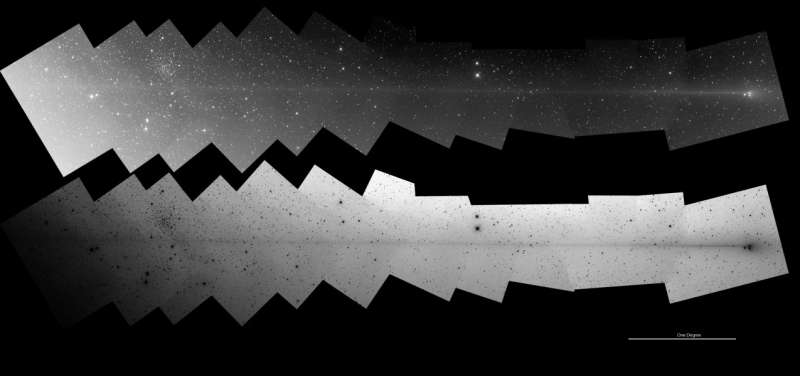
|
Credit & Copyright: Pete Lawrence
(Digital-Astronomy)
Explanation:
Once known as Earth's sunset comet,
PanSTARRS (C/2011 L4) is up all night now, but
only for northern hemisphere skygazers.
Telescopes
are required to track
its progress
as it fades and heads for the outer solar system.
But because planet Earth passed through the comet's orbital
plane in late May, PanSTARRS will also be remembered for its
remarkably long anti-tail.
That edge-on perspective looking along the broad,
fanned-out dust tail
as it trailed behind the comet created the appearance
of an anti-tail pointing in the sunward direction,
back toward the inner solar system.
Recorded on the night of May 27, this 13 pane mosaic
(shown in positive and negative views)
follows PanSTARRS' anti-tail as
it stretches
over 7 degrees from the comet's coma at the far right.
The anti-tail was likely much longer, but gets lost in the evening's
bright moonlight encroaching on the left edge of the scene.
Background star cluster NGC 188 in Cepheus shows up
along the way,
near top left.
|
January February March April May June July August September October November December |
| ||||||||||||||||||||||||||||||||||||||||||||||||
NASA Web Site Statements, Warnings, and Disclaimers
NASA Official: Jay Norris. Specific rights apply.
A service of: LHEA at NASA / GSFC
& Michigan Tech. U.
Based on Astronomy Picture
Of the Day
Publications with keywords: comet
Publications with words: comet
See also:
- APOD: 2025 November 25 Á Comet Lemmon and the Milky Way
- 3I/ATLAS: A View from Planet Earth
- APOD: 2025 November 17 Á Comet Lemmons Wandering Tail
- APOD: 2025 September 30 Á Comet Lemmon Brightens
- APOD: 2025 September 29 Á Two Camera Comets in One Sky
- APOD: 2025 September 26 Á A SWAN an ATLAS and Mars
- APOD: 2025 September 18 Á Comet C/2025 R2 SWAN
